(Optimalizované pre zariadenia s malou obrazovkou)
Pilgrimage Church and Monastery - Márianosztra, Maďarsko
Po kliknutí:
Kliknutím na obrázky!
-
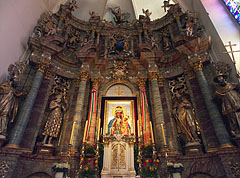
Wood-carved baroque main altar
Together with the six side altars these were created by János Hasenmiller Pauline monk, between 1724 and 1728.
Dátum fotenie: 28.4.20122012
Vytvoril: Robert Németh
Model fotoaparátu: Konica Minolta Dimage A200
Márianosztra, Maďarsko
-

The Pauline Church from inside
Dátum fotenie: 28.4.20122012
Vytvoril: Robert Németh
Model fotoaparátu: Konica Minolta Dimage A200
Márianosztra, Maďarsko
-

Our Lady of Hungary Roman Catholic Parish Church (also known as Pauline Church or Pilgrimage Church)
Dátum fotenie: 28.4.20122012
Vytvoril: Robert Németh
Model fotoaparátu: Konica Minolta Dimage A200
Márianosztra, Maďarsko
-
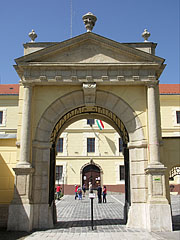
Stone gate of the Pauliner Monastry
Dátum fotenie: 28.4.20122012
Vytvoril: Robert Németh
Model fotoaparátu: Konica Minolta Dimage A200
Márianosztra, Maďarsko
-

The southern steeple with the tower clock
Dátum fotenie: 28.4.20122012
Vytvoril: Robert Németh
Model fotoaparátu: Konica Minolta Dimage A200
Márianosztra, Maďarsko
-

The building complex of the Pauline Monastery and Church in Márianosztra is a famous pilgrimage destination
Dátum fotenie: 28.4.20122012
Vytvoril: Robert Németh
Model fotoaparátu: Konica Minolta Dimage A200
Márianosztra, Maďarsko
-

The Pauline Monastery and Church was founded in 1352
Dátum fotenie: 28.4.20122012
Vytvoril: Robert Németh
Model fotoaparátu: Konica Minolta Dimage A200
Márianosztra, Maďarsko
-
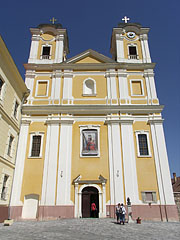
Our Lady of Hungary Roman Catholic Parish Church (also known as Pauline Church or Pilgrimage Church)
Dátum fotenie: 28.4.20122012
Vytvoril: Robert Németh
Model fotoaparátu: Konica Minolta Dimage A200
Márianosztra, Maďarsko
-
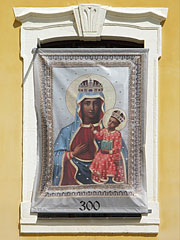
The Pilgrimage Church was reconstructed in 1729 in baroque style
Dátum fotenie: 28.4.20122012
Vytvoril: Robert Németh
Model fotoaparátu: Konica Minolta Dimage A200
Márianosztra, Maďarsko
-

Bust sculpture of Louis the Great (Louis I) King of Hungary, founder of Márianosztra settlement at the Pilgrim Church
Created by Imre Szabó, 2001
Dátum fotenie: 28.4.20122012
Vytvoril: Robert Németh
Model fotoaparátu: Konica Minolta Dimage A200
Márianosztra, Maďarsko
-
Statue of Virgin Mary from 1996, in the courtyard of the monastery
Dátum fotenie: 28.4.20122012
Vytvoril: Robert Németh
Model fotoaparátu: Konica Minolta Dimage A200
Márianosztra, Maďarsko
Statue of Virgin Mary from 1996, in the courtyard of the monastery - Márianosztra, Maďarsko -
Memorial plaque of the heroes of the village, on the wall of the church
Dátum fotenie: 28.4.20122012
Vytvoril: Robert Németh
Model fotoaparátu: Konica Minolta Dimage A200
Márianosztra, Maďarsko
Memorial plaque of the heroes of the village, on the wall of the church - Márianosztra, Maďarsko -
The church organ on the choir loft
Dátum fotenie: 28.4.20122012
Vytvoril: Robert Németh
Model fotoaparátu: Konica Minolta Dimage A200
Márianosztra, Maďarsko
The church organ on the choir loft - Márianosztra, Maďarsko -
The sanctuary and the main altar of the church
Dátum fotenie: 28.4.20122012
Vytvoril: Robert Németh
Model fotoaparátu: Konica Minolta Dimage A200
Márianosztra, Maďarsko
The sanctuary and the main altar of the church - Márianosztra, Maďarsko -
The St. Paul the First Hermit Altar and the pulpit
Dátum fotenie: 28.4.20122012
Vytvoril: Robert Németh
Model fotoaparátu: Konica Minolta Dimage A200
Márianosztra, Maďarsko
The St. Paul the First Hermit Altar and the pulpit - Márianosztra, Maďarsko -
The entrance of the Pilgrim Church from inside, an above it is the choir loft with the church organ
Dátum fotenie: 28.4.20122012
Vytvoril: Robert Németh
Model fotoaparátu: Konica Minolta Dimage A200
Márianosztra, Maďarsko
The entrance of the Pilgrim Church from inside, an above it is the choir loft with the church organ - Márianosztra, Maďarsko -
Figure of St. Elizabeth of Hungary on a stained-glass window
Dátum fotenie: 28.4.20122012
Vytvoril: Robert Németh
Model fotoaparátu: Konica Minolta Dimage A200
Márianosztra, Maďarsko
Figure of St. Elizabeth of Hungary on a stained-glass window - Márianosztra, Maďarsko -
The gothic sanctuary of the Pilgrim Church, viewed from the nave
Dátum fotenie: 28.4.20122012
Vytvoril: Robert Németh
Model fotoaparátu: Konica Minolta Dimage A200
Márianosztra, Maďarsko
The gothic sanctuary of the Pilgrim Church, viewed from the nave - Márianosztra, Maďarsko -
The right side altars: the "Five Holy Wounds of Merciful Jesus" altar and the St. Andrew's altar
Dátum fotenie: 28.4.20122012
Vytvoril: Robert Németh
Model fotoaparátu: Konica Minolta Dimage A200
Márianosztra, Maďarsko
The right side altars: the "Five Holy Wounds of Merciful Jesus" altar and the St. Andrew's altar - Márianosztra, Maďarsko -
Side altars on the left side of the church: Saint John of Capistrano's altar and the altar of Saint Paul The first Hermit
Dátum fotenie: 28.4.20122012
Vytvoril: Robert Németh
Model fotoaparátu: Konica Minolta Dimage A200
Márianosztra, Maďarsko
Side altars on the left side of the church: Saint John of Capistrano's altar and the altar of Saint Paul The first Hermit - Márianosztra, Maďarsko -
St. Jadwiga's Altar
Jadwiga was the youngest daughter of King Louis I of Hungary from the Anjou House, from 1384 she was the Queen of Poland.
Dátum fotenie: 28.4.20122012
Vytvoril: Robert Németh
Model fotoaparátu: Konica Minolta Dimage A200
Márianosztra, Maďarsko
St. Jadwiga's Altar - Márianosztra, Maďarsko -
Statue of St. Joseph and the child Jesus
Dátum fotenie: 28.4.20122012
Vytvoril: Robert Németh
Model fotoaparátu: Konica Minolta Dimage A200
Márianosztra, Maďarsko
Statue of St. Joseph and the child Jesus - Márianosztra, Maďarsko -
The carved altar of the Fatima Chapel is from 1759
Originally the current main altarpiece was here, in the place of the central white statue, until 1984.
Dátum fotenie: 28.4.20122012
Vytvoril: Robert Németh
Model fotoaparátu: Konica Minolta Dimage A200
Márianosztra, Maďarsko
The carved altar of the Fatima Chapel is from 1759 - Márianosztra, Maďarsko -
Octogonal carved baptismal font in the Fatima Chapel
Dátum fotenie: 28.4.20122012
Vytvoril: Robert Németh
Model fotoaparátu: Konica Minolta Dimage A200
Márianosztra, Maďarsko
Octogonal carved baptismal font in the Fatima Chapel - Márianosztra, Maďarsko -
Colorful stained-glass window in the Fatima Chapel, dedicated to St. Anne
It was created in 1955
Dátum fotenie: 28.4.20122012
Vytvoril: Robert Németh
Model fotoaparátu: Konica Minolta Dimage A200
Márianosztra, Maďarsko
Colorful stained-glass window in the Fatima Chapel, dedicated to St. Anne - Márianosztra, Maďarsko -
Statue of Saint Joseph at the entrance, right next to the Fatima Chapel
Dátum fotenie: 28.4.20122012
Vytvoril: Robert Németh
Model fotoaparátu: Konica Minolta Dimage A200
Márianosztra, Maďarsko
Statue of Saint Joseph at the entrance, right next to the Fatima Chapel - Márianosztra, Maďarsko -
The "Five Holy Wounds of Merciful Jesus" altar (in the middle) and the St. Andrew's altar
The latter was donated by András Szalkovics in 1726.
Dátum fotenie: 28.4.20122012
Vytvoril: Robert Németh
Model fotoaparátu: Konica Minolta Dimage A200
Márianosztra, Maďarsko
The "Five Holy Wounds of Merciful Jesus" altar (in the middle) and the St. Andrew's altar - Márianosztra, Maďarsko -
Main altar (or high altar)
Dátum fotenie: 28.4.20122012
Vytvoril: Robert Németh
Model fotoaparátu: Konica Minolta Dimage A200
Márianosztra, Maďarsko
Main altar (or high altar) - Márianosztra, Maďarsko -
The main altarpiece is a replica of the Miraculous Black Madonna of Częstochowa devotional picture (icon), it was a gift of Polish monks
Dátum fotenie: 28.4.20122012
Vytvoril: Robert Németh
Model fotoaparátu: Konica Minolta Dimage A200
Márianosztra, Maďarsko
The main altarpiece is a replica of the Miraculous Black Madonna of Częstochowa devotional picture (icon), it was a gift of Polish monks - Márianosztra, Maďarsko -
The yellow building of the Pauline Monastery
From 1858 it was a women's penitentiary, and between 1950 and 1990 it was a men's prison or jail.
Dátum fotenie: 28.4.20122012
Vytvoril: Robert Németh
Model fotoaparátu: Konica Minolta Dimage A200
Márianosztra, Maďarsko
The yellow building of the Pauline Monastery - Márianosztra, Maďarsko -
Interior of the Pauline Pilgrim Church, including the baroque style nave and the gothic style sanctuary
Dátum fotenie: 28.4.20122012
Vytvoril: Robert Németh
Model fotoaparátu: Konica Minolta Dimage A200
Márianosztra, Maďarsko
Interior of the Pauline Pilgrim Church, including the baroque style nave and the gothic style sanctuary - Márianosztra, Maďarsko -
The main gateway in the wall of the monastery, and the verdant Börzsöny Mountains in the background
Dátum fotenie: 28.4.20122012
Vytvoril: Robert Németh
Model fotoaparátu: Konica Minolta Dimage A200
Márianosztra, Maďarsko
The main gateway in the wall of the monastery, and the verdant Börzsöny Mountains in the background - Márianosztra, Maďarsko -
The garden of the Pauline monastery with the main gate
Dátum fotenie: 28.4.20122012
Vytvoril: Robert Németh
Model fotoaparátu: Konica Minolta Dimage A200
Márianosztra, Maďarsko
The garden of the Pauline monastery with the main gate - Márianosztra, Maďarsko -
One of the guard towers in the Prison of Márianosztra and the surrounding hills
Dátum fotenie: 28.4.20122012
Vytvoril: Robert Németh
Model fotoaparátu: Konica Minolta Dimage A200
Márianosztra, Maďarsko
One of the guard towers in the Prison of Márianosztra and the surrounding hills - Márianosztra, Maďarsko -
Roman Catholic Parish Church of Our Lady of Hungary (also known as Pauline Church or Pilgrimage Church)
Dátum fotenie: 28.4.20122012
Vytvoril: Robert Németh
Model fotoaparátu: Konica Minolta Dimage A200
Márianosztra, Maďarsko
Roman Catholic Parish Church of Our Lady of Hungary (also known as Pauline Church or Pilgrimage Church) - Márianosztra, Maďarsko -
The garden and the gate of the monastery
Dátum fotenie: 28.4.20122012
Vytvoril: Robert Németh
Model fotoaparátu: Konica Minolta Dimage A200
Márianosztra, Maďarsko
The garden and the gate of the monastery - Márianosztra, Maďarsko -
The alley with a row of plane trees leads to the gateway of the monastery
Dátum fotenie: 28.4.20122012
Vytvoril: Robert Németh
Model fotoaparátu: Konica Minolta Dimage A200
Márianosztra, Maďarsko
The alley with a row of plane trees leads to the gateway of the monastery - Márianosztra, Maďarsko
Kliknutím na obrázky!
Charakteristiky, vlastnosti, rysy
Poloha:
GPS súradnice: V súčasnej dobe nie je k dispozícii
Informácie, krátke poviedky, zaujímavé fakty
 The Pauline Monastery and Church was founded in 1352
The Pauline Monastery and Church was founded in 1352
The Pauline monastery of Márianosztra is a well-known place of pilgrimage long ago, it was founded by Louis I (the Great) King of Hungary in 1352. By the way, the Pauline Order (Order of Saint Paul the First Hermit) is the only one male order that was founded in Hungary. The town was organized around the monastery and probably named after the church that was dedicated to Our Lady of Hungary (Virgin Mary). The name of the town is derived from the latin term Maria Nostra which means "Our Mary".
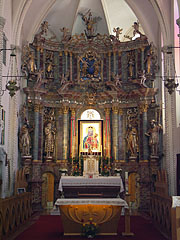 The sanctuary and the main altar of the church
The sanctuary and the main altar of the church
The former church of Márianosztra was ruined during the Turkish occupation of Hungary, so a new baroque church was built (designed by Máté Vépi Pauline monk), which was then consecrated in 1729 and this can be seen today. Except for some shorter periods the church and the monastery was owned by the Paulines until 1786, when Joseph II, Holy Roman Emperor and King of Hungary dissolved this religious order by a decree. Although the church continued to function, the monastery was empty right until 1858. Then by the order of the emperor it was converted to a women's prison and its management was passed to the Vincentian Sisters. By 1950 during the Communist era it became a penitentiary and prison for men. Between 1989-1991 those premises and buildings which were not used by the correctional facility were passed back to the Pauline monks to take care.
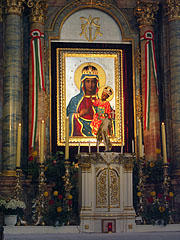 The main altarpiece is a replica of the Miraculous Black Madonna of Częstochowa devotional picture (icon), it was a gift of Polish monks
The main altarpiece is a replica of the Miraculous Black Madonna of Częstochowa devotional picture (icon), it was a gift of Polish monks
At the time of the Ottoman rule in Hungary the Pauline monastery and church were ravaged and plundered, the building complex was begun to be ruined. The reconstruction of the building and the recovery of the monastic life could have begun again in 1712, thanks to the foundation of György Széchenyi and the monks who arrived here from Częstochowa town, Poland. These monks also brought a replica of the famous miraculous Black Madonna of Częstochowa with themselves and gave it to the Paulines as a gift. The rapidly growing popularity and respect of the picture was also expressed by crowns, which were painted on the head of Mary and the child Jesus in 1749. However, the current "crowns" on the figures of the picture were created later, these headgears imitate the Hungarian Holy Crown and were placed on the devotional picture just in 1983 by the request of Cardinal Archbishop László Lékai.
Częstochowa is a city and famous place of pilgrimage in Poland. The famous Black Madonna or Our Lady of Częstochowa icon (sacred picture) is kept here in the Pauline monastery of the 293-meter-high Jasna Góra ("Luminous Hill"). Allegedly the devotional picture has miraculous power, but it is also one of the symbols of the Polish Catholicism and independence. The icon picture was arrived into Poland into the Jasna Góra Monastery in 1382, from Jerusalem through Constantinople and Belz. The monastery was established by King Louis the Great (Louis I of Hungary) also in 1832, then in the same year he gave it to the Hungarian Pauline Order (Order of Saint Paul). According to a legend the icon was painted by St. Luke the Evangelist himself on a cedarwood board.
There are at least two authentical copies of the Black Madonna of Częstochowa icon in the present-day Hungary. One was a gift of the Polish people in 1994, for the 60th anniversary of the event when the Pauline Order came back to Hungary. This one was placed in the Gellért Hill Cave Church in Budapest, and in 2011 another replica was placed into the St. Stephen's Basilica also in Budapest city.
Tiež by vás mohlo zaujímať (Súvisiace stránky):
Destinácie v cestovnom sprievodcu:
Márianosztra (37 fotky)
Börzsöny Mountains (218 fotky)
Pest megye (county) (15 122 fotky + 50 panoramatické zábery)
Budapešť a jeho okolie (15 989 fotky + 52 panoramatické zábery)
Maďarsko (27 287 fotky + 163 panoramatické zábery)
a okrem toho:
(v rámci tu: Pest megye a Börzsöny Mountains)
Pilis Mountains (Pilis hegység) (335 fotky)
Buda Hills (Budai-hegység) (8 632 fotky + 21 panoramatické zábery)
Gödöllő Hills (Gödöllői-dombság) (4 203 fotky + 21 panoramatické zábery)
Cegléd (125 fotky + 2 panoramatické zábery)
Ráckeve (92 fotky)
Dunakeszi (259 fotky)
Göd (23 fotky)
Nagykőrös (250 fotky + 2 panoramatické zábery)
Nagymaros (31 fotky)
Pilisvörösvár (88 fotky)
Szentendre (597 fotky + 1 panoramatické zábery)
Vác (232 fotky + 2 panoramatické zábery)
Visegrád (220 fotky + 1 panoramatické zábery)
Nagymaros (31 fotky)
Csővár (105 fotky)
Kóspallag (53 fotky)
Nagybörzsöny (4 fotky)
Pilisszentkereszt (122 fotky)
Diósjenő (68 fotky)
Kóspallag (53 fotky)
Nagybörzsöny (4 fotky)
Zsámbék
Každá panoramatické fotografie tu:
Márianosztra ( fotky)
Pest megye (county) (50 fotky)
Budapešť a jeho okolie (52 fotky)
Maďarsko (163 fotky)
Európa (165 fotky)
Každý normálny foto tu:
Márianosztra (37 fotky)
Börzsöny Mountains (218 fotky / 6 galéria)
Pest megye (county) (15 122 fotky / 221 galéria)
Budapešť a jeho okolie (15 989 fotky / 234 galéria)
Maďarsko (27 287 fotky / 462 galéria)
Európa (30 494 fotky / 523 galéria)
https://www.panadea.com/sk/guidebook/marianosztra/photos/gal-001

Pridať k Obľúbeným Pridať k Záložkám
Zdieľajte so svojimi priateľmi!
atď.
Náš cestovný sprievodca obsahuje:
Početné fotky a panoramatické obrázky, s množstvom informácií a zaujímavých faktov.
- 214 turistické destinácie
- 165 panoramatické zábery
- 30 494 ďalšie fotografie
Veľká zbierka vybraných fotografií: výborná kvalita, vysoké rozlíšenie a prirodzené farby
Všetky práva vyhradené
- ©2010-2022
Neuronit Creative Studio - Mogyoród / Budapešť / Maďarsko





